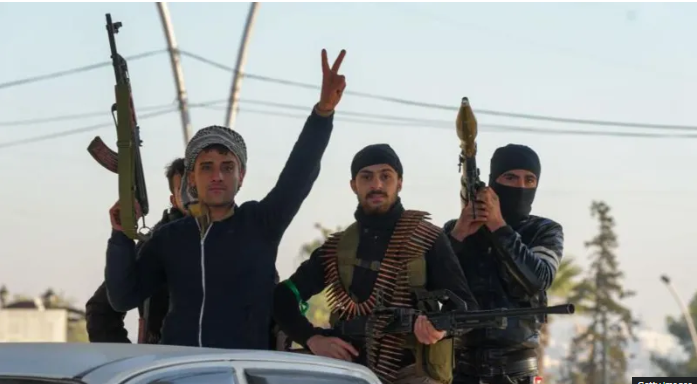
The leader of the Islamist militant group, Hayat Tahrir al-Sham (HTS), Abu Mohammed al-Jolani, is very much putting himself forward as the figurehead of a post-Assad future in Syria.
Without his group’s sudden, devastating advance on Aleppo and then into Hama and Homs from their powerbase in the north-western province of Idlb, there is no doubt that the tumultuous events of the past week and a half would not have happened.
But other rebel groups rose up too – and it was most likely that sense of the entirety of Syria turning on the regime that so swiftly led to its collapse.
Syria’s Assad falls – follow live updates
BBC in Umayyad Square amid deafening gunfire
Watch: Presidential palace stormed in Damascus
Where is Bashar al-Assad?
Among these groups – some now in Damascus – are rebel factions that once operated under the banner of the Free Syrian Army from southern towns and cities that had been dormant for years, but where the spark of rebellion had never entirely been sniffed out.
Over to the east, Kurdish-led forces have benefited from the collapse of the Syrian army to take full control of the main city, Deir El-Zour. In the vast Syrian desert, remnants of the so-called Islamic State could also look to take advantage of the situation. And in the far north along the Turkish border, the Syrian National Army – backed by Ankara – could also prove to be a significant player in what happens next.
Al-Jolani has for years endeavoured to shift the perception of his organisation from one to be feared for its ideological zealotry into one that could be accepted by Syrians as a pragmatic alternative to the Assad regime.
HTS was set up under a different name, Jabhat al-Nusra, in 2011 as a direct affiliate of al-Qaeda.
The leader of the self-styled Islamic State (IS) group, Abu Bakr al-Baghdadi, was also involved in its formation.
It was regarded as one of the most effective and deadly of the groups ranged against President Assad.
It was proscribed as a terrorist group by the UN, the US, Turkey and other countries – and it remains so.
But al-Jolani publicly broke ranks with al-Qaeda, dissolved Jabhat al-Nusra and set up a new organisation, which took the name Hayat Tahrir al-Sham (HTS) when it merged with several other similar groups a year later.
There were doubts at the time – and some still remain – over whether HTS had completely renounced its links with al-Qaeda. But its message in the past week and a half has been one of inclusiveness and a rejection of violence or revenge.
The group has in the past been involved in internecine conflict with other rebel and opposition groups. That could well happen again.
The end of President Assad’s rule does not in any way change for now the divisions within Syria, where different groups have held various territories outside government control.
Efforts by HTS towards legitimacy have also been tarnished by alleged human rights abuses.
How Syria’s immediate political future develops will not only depend on the organisation’s intentions and capabilities, as well as the competing claims and pressures from other groups, but also on the part that the major outside powers that have been most closely involved in the country’s recent history will play.
They include most notably Iran and Russia – who supported President Assad – and Turkey – which has backed rebel groups -, as well as the US which still maintains a military presence in the Kurdish-held east of the country.
They are now playing catch up, as they try to set a new strategic course to serve their interests in the aftermath of the downfall of the Assad dynasty.






